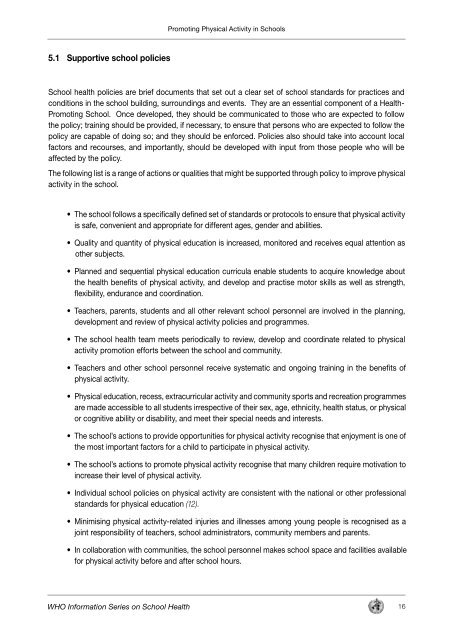WHO INFORMATION SERIES ON SCHOOL HEALTH ... - PAHO/WHO
WHO INFORMATION SERIES ON SCHOOL HEALTH ... - PAHO/WHO
WHO INFORMATION SERIES ON SCHOOL HEALTH ... - PAHO/WHO
Create successful ePaper yourself
Turn your PDF publications into a flip-book with our unique Google optimized e-Paper software.
5.1 Supportive school policies<br />
Promoting Physical Activity in Schools<br />
School health policies are brief documents that set out a clear set of school standards for practices and<br />
conditions in the school building, surroundings and events. They are an essential component of a Health-<br />
Promoting School. Once developed, they should be communicated to those who are expected to follow<br />
the policy; training should be provided, if necessary, to ensure that persons who are expected to follow the<br />
policy are capable of doing so; and they should be enforced. Policies also should take into account local<br />
factors and recourses, and importantly, should be developed with input from those people who will be<br />
affected by the policy.<br />
The following list is a range of actions or qualities that might be supported through policy to improve physical<br />
activity in the school.<br />
• The school follows a specifically defined set of standards or protocols to ensure that physical activity<br />
is safe, convenient and appropriate for different ages, gender and abilities.<br />
• Quality and quantity of physical education is increased, monitored and receives equal attention as<br />
other subjects.<br />
• Planned and sequential physical education curricula enable students to acquire knowledge about<br />
the health benefits of physical activity, and develop and practise motor skills as well as strength,<br />
flexibility, endurance and coordination.<br />
• Teachers, parents, students and all other relevant school personnel are involved in the planning,<br />
development and review of physical activity policies and programmes.<br />
• The school health team meets periodically to review, develop and coordinate related to physical<br />
activity promotion efforts between the school and community.<br />
• Teachers and other school personnel receive systematic and ongoing training in the benefits of<br />
physical activity.<br />
• Physical education, recess, extracurricular activity and community sports and recreation programmes<br />
are made accessible to all students irrespective of their sex, age, ethnicity, health status, or physical<br />
or cognitive ability or disability, and meet their special needs and interests.<br />
• The school’s actions to provide opportunities for physical activity recognise that enjoyment is one of<br />
the most important factors for a child to participate in physical activity.<br />
• The school’s actions to promote physical activity recognise that many children require motivation to<br />
increase their level of physical activity.<br />
• Individual school policies on physical activity are consistent with the national or other professional<br />
standards for physical education (12).<br />
• Minimising physical activity-related injuries and illnesses among young people is recognised as a<br />
joint responsibility of teachers, school administrators, community members and parents.<br />
• In collaboration with communities, the school personnel makes school space and facilities available<br />
for physical activity before and after school hours.<br />
<strong>WHO</strong> Information Series on School Health 16

















